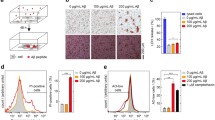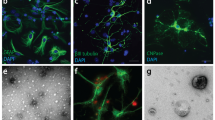Abstract
Summary
The fine structural features of cultured PC12 cells were investigated after treatment for 1, 3, or 5 days with different concentrations of the vascular form of β- 1–40 (β-AP). PC12 cells treated with β-AP showed time- and concentration-dependent lysosomal system activation and cell toxicity. We observed increases in the number and size of cytoplasmic lysosomes as indicated by increased acid phosphatase reactivity. Some lysosomes were in the form of multivesicular bodies or large residual bodies that appeared to arise by autophagia or by endocytotic uptake. Double-sided plasma membrane invaginations were observed to give rise to increasingly extensive intracytoplasmic vacuolization that was correlated with duration of β-AP treatment. Freeze-fracture studies of the intramembranous particle (IMP) population in the plasma membrane P-face showed that both control and β-AP treated cells had two major P-face IMP populations, small-diameter (4–8 nm) IMPs, and large-diameter (≤ 9nm) IMPs. The larger category of IMPs was found to possess a greater average diameter in the β-AP treated cells than in the control cells. These IMPs could represent modifications to existing transmembranous receptors, channels, or transducing molecules by the β-AP. These results demonstrate that β-AP can induce time- and concentration-dependent ultrastructural changes in PC12 cell membranes.
Similar content being viewed by others
References
Allen, D.D., Galdzicki, Z., Brining, S., Fukuyama, R., Rapoport, S.I. & Smith, Q.R. (1997) Beta-amyloid-induced increase in choline flux across PC12 cell membranes. Neuroscience Letters 234, 71-73.
Arispe, N., Rojas, E. & Pollard, H.B. (1993) Alzheimer disease amyloid beta protein forms calcium channels in bilayer membranes: blockade by tromethanmine and aluminum. Proceedings of the National Academy of Sciences USA 90, 567-71.
Behl, C., David, J.B., Klier, F.G. & Schubert, P. (1994) Amyloid beta peptide induces necrosis rather than apoptosis. Brain Research 645, 253-64.
Boissiere, F., Leherricy, S., Strada, O., Agid, Y. & Hirsch, E.C. (1996) Neurotrophin receptors and selective loss of cholinergic neurons in Alzheimer disease. Molecular and Chemical Neuropathology 28, 219-223.
Butterfield, D.A., Hensley, K., Harris, M. & Mattson, M. (1994) β-Amyloid peptide free radical fragments initiate synaptosomal lipoperoxidation in an sequence-specific fashion: implications to Alzheimer′s disease. Biochemical and Biophysical Research Communications 200, 710-15.
Butterfield, D.A., Nicholas, M.M. & Markesbery, W.R. (1985) Evidence for an increased rate of choline efflux across erythrocyte membranes in Alzheimer′s disease. Neurochemical Research 10, 909-18.
Cataldo, A.M. & Nixon, R.A. (1990) Enzymatically active lysosomal proteases are associated with amyloid deposits in Alzheimer brain. Proceedings of the National Academy of Sciences USA 87, 3861-65.
Davidson, R.M., Shajenko, L. & Donta, T.S. (1994) Amyloid beta-peptide potentiates a nimodipine-sensitive L-type barium conductance in NIE-115 neuroblastoma-cells. Brain Research 643, 324-27.
Ehrenstein, G., Galdzicki, Z. & Lange, G.D. (1997) The choline-leakage hypothesis for the loss of acetylcholine in Alzheimer′s disease. Biophysical Journal 73, 1276-80.
Etcheberrigaray, R., Ito, E., Kim, C.S. & Alkon, D.L. (1994) Soluble beta-amyloid induction of Alzheimer′s phenotype for human fibroblast K+ channels. Science 264, 276-9.
Fukuyama, R., Wadhwani, K.C., Galdzicki, Z., Rapoport, S.I. & Ehrenstein, G. (1994) β-Amyloid polypeptide increases calcium-uptake in PC12 cells: a possible mechanism for its cellular toxicity in Alzheimer′s disease. Brain Research 667, 269-72.
Galdzicki, Z., Fukuyama, R., Wadhwani, K.C., Rapoport, S.I. & Ehrenstein, G. (1994) β-Amyloid increases choline conductance of PC12 cells: possible mechanism of toxicity in Alzheimer′s disease. Brain Research 646, 332-6.
Gershfeld, N.L. & Ginsberg, L. (1995) Membrane bilayer instability as a pathogenetic mechanism for neurological disease. Reviews of Neuroscience 6, 1-13.
Ginsberg, L., Rafique, S., Xuereb, J.H., Rapoport, S.I. & Gershfel d, N.L. (1995) Disease and anatomic specificity of ethanolamine plasmalogen deficiency in Alzheimer′s disease brain. Brain Research 698, 223-6.
Greene L.A. & Tischler A.S. (1982) PC12 cells pheochromocytoma cells in neurobiological research. Advances in Cellular Neurobiology 3, 373-414.
Hartmann, T., Masters, C.L. & Beyreuther, K. (1996) Genes contributing to Alzheimer′s disease. Molecular Psychiatry 1, 27-40.
Hong K., Hubbel W.K. (1972) Preparation and properties of phospholipid bilayers containing rhodopsin. Proceedings of the National Academy of Sciences USA 69, 2617-21.
Kowall, N.W., McKee, A.C., Yankner, B.A. & Beal, M.F. (1992) In vivo neurotoxicity of beta-amyloid [beta(1-40)] and the beta (25-35) fragment. Neurobiology of Aging 13, 537-42.
Lane, N.J., Rapoport, S.I., Balbo, A. & Galdzicki, Z. (1995) Effects of β-amyloid peptide over time on the fine structure of cultured PC12 cells (abstract) Molecular Biology of the Cell 6, 217A.
Mattson, M.P., Barger, S.W., Cheng, B., Leiberburg, I.L., Smith-Swintosky, V.L. & Rydel, R.E. (1992) β-Amyloid precursor protein metabolites and loss of neuronal Ca2+ homeostasis in Alzheimer′s disease. Trends in Neuroscience 16, 409-14.
Mattson, M.P. & Goodman, Y. (1995) Different amyloidogenic peptides share a similar mechanism of neurotoxicity involving reactive oxygen species and calcium. Brain Research 676, 219-24.
Michel, P.P., Vyas, S., Anglade, P., Ruberg, M. & Agid, Y. (1994) Morphological and molecular characterization of the response of differentiated PC12 cells to calcium stress. European Journal of Neuroscience 6, 577-86.
Nitsch, R.M., Slack, B.E., Wurtman, R.J. & Growdon, J.H. (1992) Release of Alzheimer amyloid precursor derivatives stimulated by activation of muscarinic acetylcholine receptors. Science 258, 304-7.
Nixon, R.A. & Cataldo, A.M. (1995) The endosomal-lysosomal system of neurons: new roles. Trends in Neuroscience 18, 489-96.
Novikoff, A.B. (1963) Lysosomes in the physiology and pathology of cells: contributions of staining methods. In: Ciba Foundation Symposium on Lysosomes (edited by de Reuck, A.V.S. & Cameron, M.P.) Boston: Little, Brown and Company.
Pearce, R., Fukuyama, R. Galdzicki, Z., Ehrenstein, G. & Rapoport, S.I. (1994) Alzheimer′s disease β-amyloid affects inherent channel activity of PC12 cells. Biophysical Journal 66, A430.
Rosenbluth, J. (1983) Electrophysiology and morphology of myelinated nerve fibers. V. Intramembranous particle distribution in nerve fiber membranes. Experientia 39, 953-63.
Selkoe, D. J. (1997) Alzheimer′s disease: genotypes, phenotypes, and treatments. Science 275, 630-1.
Slotkin, T.A., Seidler, F.J., Crain, B.J., Bell, J.M. & Bissette, G. (1990) Regulatory changes in presynaptic cholinergic function assessed in rapid autopsy material from patients with Alzheimer disease: implications for etiology and therapy. Proceedings of the National Academy of Sciences USA 87, 2452-5.
Trump, B.F., Berezesky, I.K., Chang, S.H. & Phelps, P.C. (1997) The pathways of cell death: oncosis, apoptosis, and necrosis. Toxicology and Pathology 25, 82-8.
Watt, J.A., Pike, C.J., Walencewicz-Wasserman, A.J. & Cotman, C.W. (1994) Ultrastructural analysis of beta-amyloid-induced apoptosis in cultured hippocampal neurons. Brain Research 661, 147-56.
Wurtman, R.J. (1992) Choline metabolism as a basis for the selective vulnerability of cholinergic neurons. Trends in Neuroscience 15, 117-22.
Author information
Authors and Affiliations
Rights and permissions
About this article
Cite this article
Lane, N., Balbo, A., Fukuyama, R. et al. The ultrastructural effects of β-amyloid peptide on cultured PC12 cells: changes in cytoplasmic and intramembranous features.. J Neurocytol 27, 707–718 (1998). https://doi.org/10.1023/A:1006976400227
Issue Date:
DOI: https://doi.org/10.1023/A:1006976400227




